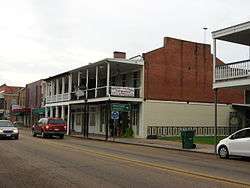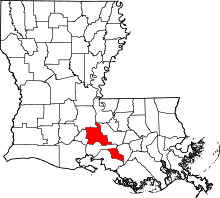St. Martinville, Louisiana
| Saint Martinville, Louisiana | |
|---|---|
| City | |
|
Main Street in St. Martinville | |
 Location of St. Martinville in St. Martin Parish, Louisiana. | |
.svg.png) Location of Louisiana in the United States | |
| Coordinates: 30°07′30″N 91°49′50″W / 30.12500°N 91.83056°WCoordinates: 30°07′30″N 91°49′50″W / 30.12500°N 91.83056°W | |
| Country | United States |
| State | Louisiana |
| Parish | St. Martin |
| Government | |
| • Mayor |
Thomas Nelson (D) |
| Area[1] | |
| • Total | 3.20 sq mi (8.28 km2) |
| • Land | 3.09 sq mi (8.00 km2) |
| • Water | 0.11 sq mi (0.28 km2) |
| Elevation | 23 ft (7 m) |
| Population (2010) | |
| • Total | 6,114 |
| • Estimate (2016)[2] | 6,095 |
| • Density | 1,973.77/sq mi (762.17/km2) |
| Time zone | CST (UTC-6) |
| • Summer (DST) | CDT (UTC-5) |
| ZIP code | 70582 |
| Area code(s) | 337 |
| FIPS code | 22-67600 |
| Website | http://www.stmartinville.org/ |
St. Martinville is a small city in and the parish seat of St. Martin Parish, Louisiana, United States.[3] It lies on Bayou Teche, sixteen miles south of Breaux Bridge, eighteen miles southeast of Lafayette, and nine miles north of New Iberia. The population was 6,114 at the 2010 census, down from 6,989 at the 2000 census. It is part of the Lafayette Metropolitan Statistical Area.
Geography
St. Martinville is located at 30°7′30″N 91°49′50″W / 30.12500°N 91.83056°W (30.125053, -91.830593).[4]
According to the United States Census Bureau, the city has a total area of 3.0 square miles (7.8 km²), of which, 3.0 square miles (7.8 km²) of it is land and 0.33% is water. Its terrain is mixture of swamp and prairie.
History
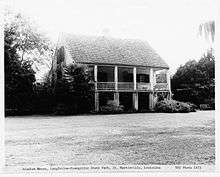
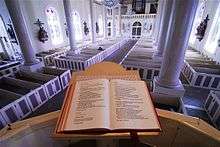
In the 16th century, the area between the Atchafalaya River, in Louisiana, the Gulf of Mexico and Trinity River, in Texas, was occupied by numerous Indians tribes or subdivisions of the Attakapan people. The Indian Territory was not closed to outsiders, and several traders roamed through it on business. Europeans did not begin to settle there until French explorers claimed and "founded" Louisiana in 1699. They referred to the territory between the Atchafalaya River and Bayou Nezpique, where the Eastern Atakapa lived, as the Attakapas Territory, adopting the name from the Choctaw language term for this people. The French colonial government gave land away to soldiers and settlers.
Attakapas Post was founded as a trading post on the banks of the Bayou Teche, and settlers started to arrive. Some came separately from France, such as M. Masse, who came about 1754 from Grenoble. Gabriel Fuselier de la Claire, a Frenchman from Lyon, and some other Frenchmen from Mobile, in present-day Alabama, arrived in late 1763/early 1764. Fuselier bought land between Vermilion River and Bayou Teche from the Eastern Attakapas chief Kinemo. Shortly after that, the rival Appalousa (Opelousa people) invaded the area via the Atchafalaya and Sabine rivers, and exterminated much of the Eastern Atakapan. Gabriel Fuselier's son Agricole Fuselier was prominent in settling what developed as New Iberia, Louisiana.
Gradually groups of more French speakers arrived, such as the first Acadians from Nova Scotia. They were assigned to this area in 1765 by Jean-Jacques Blaise d'Abbadie, the French official who was administering Louisiana for the Spanish. They had been expelled from Acadia by the British, who had defeated France in the Seven Years' War and taken over its territories in North America east of the Mississippi River. Spain took over Louisiana and other territories west of the Mississippi but tended to rely on French colonists to administer La Louisiane.
The Acadians were led by Joseph Broussard dit Beausoleil. In 1768-1769 fifteen families arrived from Pointe Coupee, another French colonial community. Their members had migrated from Santo Domingo (French Saint Domingue, today Haïti) or from Paris via Fort de Chartres, Illinois. Between the arrivals of the two groups, the French captain Etienne de Vaugine came in 1764 and acquired a large domain east of Bayou Teche.
On April 25, 1766, after the arrival of the first Acadians, the census showed a population of 409 inhabitants for the Attakapas region. In 1767 the Attakapas Post had 150 inhabitants before the arrival of the 15 families from Pointe Coupee.
In 1803, after losing his effort to regain control over Saint-Domingue, Napoleon sold Louisiana in 1803 to the United States through the Louisiana Purchase. The US settlers and territorial government organized the Attakapas Territory between 1807 and 1868. After Louisiana became a state, Saint Martin Parish was created. Attakapas Post was named Saint Martinville and designated as the county seat.
Demographics
| Historical population | |||
|---|---|---|---|
| Census | Pop. | %± | |
| 1850 | 652 | — | |
| 1870 | 1,190 | — | |
| 1880 | 1,606 | 35.0% | |
| 1890 | 1,814 | 13.0% | |
| 1900 | 1,926 | 6.2% | |
| 1910 | 2,318 | 20.4% | |
| 1920 | 2,465 | 6.3% | |
| 1930 | 2,455 | −0.4% | |
| 1940 | 3,501 | 42.6% | |
| 1950 | 4,614 | 31.8% | |
| 1960 | 6,468 | 40.2% | |
| 1970 | 7,153 | 10.6% | |
| 1980 | 7,965 | 11.4% | |
| 1990 | 7,137 | −10.4% | |
| 2000 | 6,989 | −2.1% | |
| 2010 | 6,114 | −12.5% | |
| Est. 2016 | 6,095 | [2] | −0.3% |
As of the census[6] of 2010, there were 6,114 people, 2,320 households, and 1,533 families residing in the city. The population density was 2,038 people per square mile (899.5/km²). There were 2,588 housing units at an average density of 862.67 per square mile (357.5/km²). The racial makeup of the city was 35.3% White, 62.7% African American, 0.20% Native American, 0.1% Asian, 0.2% from other races, and 1.3% from two or more races. Hispanic or Latino of any race were 1.4% of the population. In 2005, 81.1% of the population over the age of five spoke only English at home, 15.9% of the population spoke French, and 2.7% spoke Louisiana Creole French.[7]
There were 2,320 households out of which 27.7% had children under the age of 18 living with them, 31.5% were married couples living together, 28.7% had a female householder with no husband present, and 33.9% were non-families. 28.7% of all households were made up of individuals and 12.4% had someone living alone who was 65 years of age or older. The average household size was 2.52 and the average family size was 3.13.
In the city, the population was spread out with 24.9% under the age of 18, 6.6% from 20 to 24, 22.8% from 25 to 44, 26.9% from 45 to 64, and 15.8% who were 65 years of age or older. The median age was 38.8 years. For every 100 females there were 85.8 males. For every 100 females age 18 and over, there were 80.7 males.
The median income for a household in the city was $24,246 and the median income for a family was $33,009. Males had a median income of $30,710 versus $33,455 for females. The per capita income for the city was $17,835. About 24.6% of families and 29.4% of the population were below the poverty line, including 50.2% of those under age 18 and 16.2% of those age 65 or over.
Education
Public schools in St. Martin Parish are operated by the St. Martin Parish School Board. The city of St. Martinville is zoned to the Early Learning Center (Grades PK-K), St. Martinville Primary School (Grades 1-4), St. Martinville Junior High School (Grades 5-8) and St. Martinville Senior High School (Grades 9-12).[8] The Evangeline campus of Louisiana Technical College is located in St. Martinville.
Economy
The economy of St. Martinville is fueled by agriculture and tourism. Agricultural production mainly yields crops of crawfish and sugar cane. The latter was a major commodity crop before the American Civil War, when it was dependent on the labor of African-American slaves. It has continued to be important.
- St. Martin Parish contributes over 8,000,000 pounds of wild crawfish from the Atchafalaya Basin and another 14,000,000 pounds harvested from farming ponds annually to the overall production of Louisiana crawfish.
- The Louisiana Sugar Cane Co-Op and historic St. John Mill, which is administered in St. Martinville, manage about 34,000 acres producing sugar cane throughout the State of Louisiana.
- Cajun Chef Products, Inc. is the largest employer in the city. For 30 years, the Bulliard family has built a tradition of supplying quality Cajun food products nationwide. The business that began in 1958 with one product now distributes more than 250 products through fast food and other restaurants as well as other institutions. Approximately 100 employees maintain the local plant.
- Peppers Unlimited of Louisiana, Inc. employs approximately 60 people from the St. Martinville area. The Bulliard family hot sauce recipe dates back to the turn of the 20th century, in 1910. There are four generations of Bulliards now represented in the pepper business. Products processed at the St. Martinville plant are made under the Louisiana Supreme label or private labels and are sold internationally.
Society
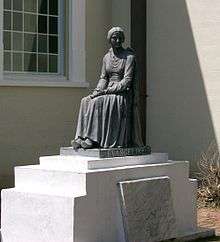
St. Martinville is widely considered to be the birthplace of the Cajun culture and traditions, and it is in the heart of Cajun Country. A multicultural community in St. Martinville, with Acadians and Cajuns, Creoles (French coming via the French West Islands - Guadeloupe, Martinique and Santo Domingo), French, Spaniards, Africans and African Americans. Once New Orleans was founded and began to have epidemics, some New Orleanians escaped the city and came to St. Martinville. Its nickname, Petit Paris ("Little Paris"), dates from the era when St. Martinville was known as a cultural mecca with good hotels and a French theater, the Duchamp Opera House (founded in 1830), which featured the best operas and witty comedies.
The third oldest town in Louisiana, St. Martinville has many buildings and homes with beautiful architecture. The historic St. Martin de Tours Catholic Church and La Maison Duchamp on Main Street are part of the legacy of the Acadian people. The church was dedicated to Martin of Tours in France, where a St Martin de Tours church can be found. St. Martinville is the site of the "Evangeline Oak", featured in Henry Wadsworth Longfellow's poem about the Acadian expulsion.
It is also the site of an African American Museum, and is included as a destination on the Louisiana African American Heritage Trail, which was established in 2008.[9][10]
Notable people
- Calvin Borel, jockey, three-time Kentucky Derby winner.
- Jefferson J. DeBlanc (15 February 1921- 22 November 2007), World War II ace fighter pilot and Medal of Honor recipient. Resided in St. Martinville and is buried in the town's Catholic cemetery.
- Early Doucet, wide receiver for the LSU Fighting Tigers (2004–2008) and the Arizona Cardinals (2008–2012).
- Charles Fuselier, sheriff of St. Martin Parish, 1980–2003; "National Sheriff of the Year" in 1996.
- Paul Jude Hardy, first Republican to be elected Lieutenant Governor of Louisiana (1988–1992).
- Jay Hebert, professional golfer, 1960 PGA Championship winner.
- Jeff Landry, Republican congressman for the Third Congressional District (2011–2013) and Attorney General of Louisiana (2016–).
- Fred H. Mills, Jr., Republican state representative for St. Martin Parish.
- Nathan Williams, zydeco accordionist and singer.
Festivals
- La Grande Boucherie des Cajuns - sponsored by the St. Martinville Main Street Association a Louisiana non-profit organization benefiting the preservation, design, organization and the economic development of St. Martinville and other civic projects
- Pepper Festival - sponsored by the Kiwanis Club of St. Martinville
- Acadian Memorial Heritage Festival and Wooden Boat Congrès - promoting the preservation of Acadian culture and French language in Louisiana. This daylong festival is held on the third Saturday of March annually. The festival is sponsored by The Acadian Memorial Foundation and The Museum of the Acadian Memorial
Attractions
St. Martin de Tours Church is the oldest church parish in southwest Louisiana. It is known as the Mother Church of the Acadians because it was founded in 1765 upon the arrival of Acadians in this area. The current building has served as a center for religious activities in this predominantly Catholic community for over one hundred fifty years. At the side of the St. Martin de Tours Church is a monument dedicated to the Militiamen of St Martinville (36 of the militiamen were French Creoles, three were Acadians, and three colonial Americans, one's citizenship was not known) who took part with General Bernardo de Galvez in the Battle of Baton Rouge. The monument was erected by the Louisiana Daughters of the American Revolution.
La Maison Duchamp on Main Street in St. Martinville, Louisiana was built by Eugène and Amélie Duchamp in 1876 as their town house. This St. Martinville landmark house has been listed on the National Register of Historic Places; future generations will be able to see its creative architecture.
Duchamp Opera House, which dates to the mid-19th century, hosted many theatrical companies in its lifetime and has recently been completely restored. It once again hosts theatrical companies on the second floor.
The Evangeline Oak, made famous in Henry Wadsworth Longfellow's poem, "Evangeline", stands on the bank of the Bayou Teche. Longfellow-Evangeline State Historic Site, containing an eighteenth-century Acadian cabin, the Creole Maison Olivier, and a museum interpreting Acadian life, is located north of the historic district.
The St. Martinville post office contains a mural, Evangeline, painted in 1940 by Minetta Good. Murals were produced from 1934 to 1943 in the United States through the Section of Painting and Sculpture, later called the Section of Fine Arts, of the Treasury Department.
The African American Museum, located in the historic district, uses the latest technology to provide insights into the culture and life of the Free People of Color in the community and their contributions to the Attakapas region from the 1750s on. They were integral to building and service trades. Many descended from Africans from the Senegambian region of West Africa and from French and Spanish colonists.
The newly renovated Old Teche Theater offers entertainment to the town. The 1930s Art Deco movie house is now converted into a television and film studio as well as a performing arts venue and recording studio.
Sister cities
- Ploermel, Brittany, France
- Bouctouche, New Brunswick, Canada
- Chaudfontaine, Wallonia, Belgium
- Goree Island, Senegal, West Africa
References
- ↑ "2016 U.S. Gazetteer Files". United States Census Bureau. Retrieved Jul 2, 2017.
- 1 2 "Population and Housing Unit Estimates". Retrieved June 9, 2017.
- ↑ "Find a County". National Association of Counties. Retrieved 2011-06-07.
- ↑ "US Gazetteer files: 2010, 2000, and 1990". United States Census Bureau. 2011-02-12. Retrieved 2011-04-23.
- ↑ "Census of Population and Housing". Census.gov. Retrieved June 4, 2015.
- ↑ "American FactFinder". United States Census Bureau. Retrieved 2017-05-03.
- ↑ http://www.mla.org/cgi-shl/docstudio/docs.pl?map_data_results
- ↑ Archived August 26, 2012, at the Wayback Machine.
- ↑ Kimberly Quillen, "African American Heritage Trail unveiled in New Orleans this morning", Times Picayune, 27 February 2008, accessed 17 January 2015
- ↑ "A Story Like No Other: African American Heritage Trail", website
External links
| Wikimedia Commons has media related to St. Martinville, Louisiana. |
- City of St. Martinville
- "On The Road To St. Martinville, Louisiana," an on-line photo journal of historic St. Martinville, Louisiana.
